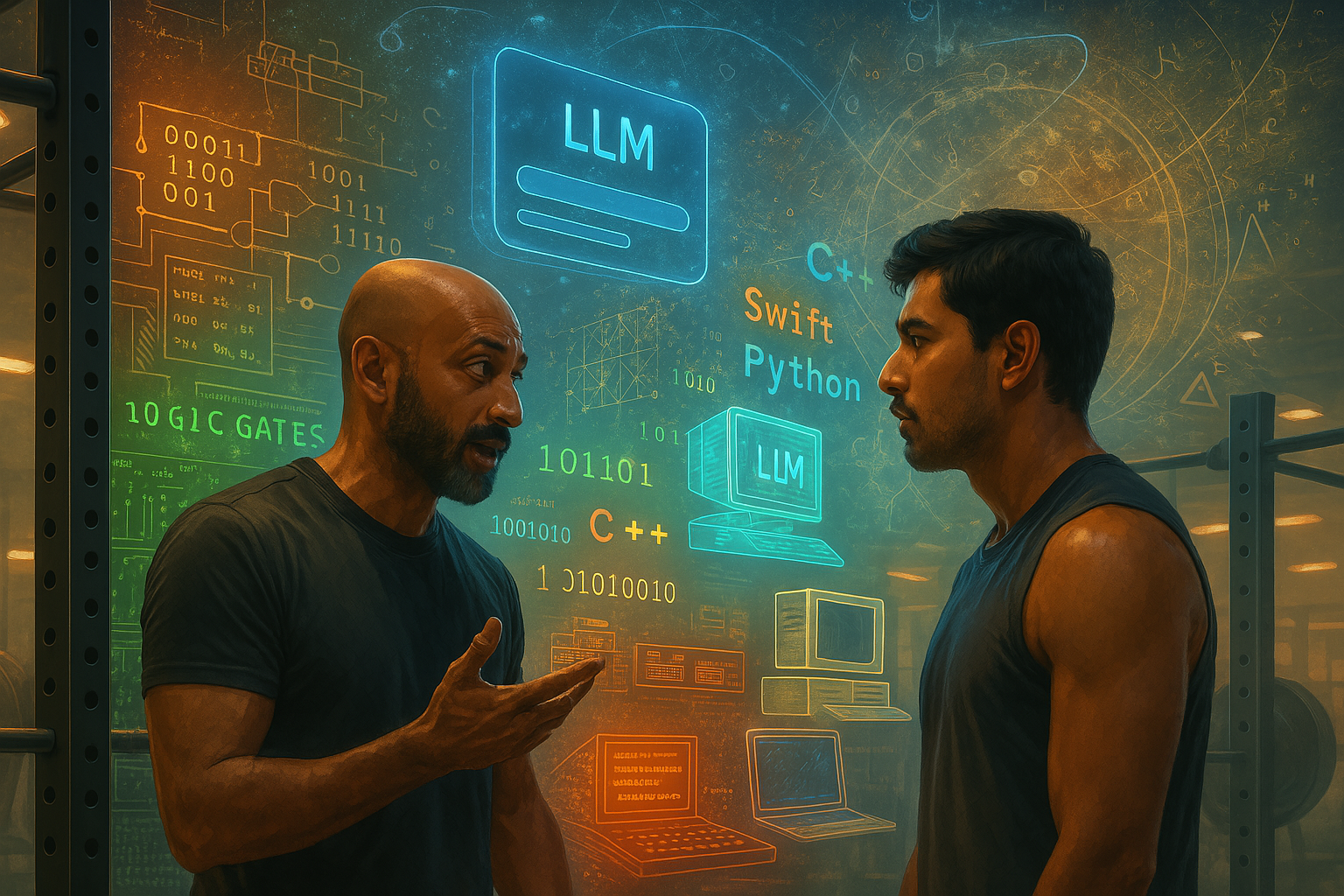Reflexive by Default: The Role of Human Beings in an AI-Driven World
Posted April 13, 2025 by Gowri Shankar ‐ 8 min read
Like every self-respecting tech bro armed with a half-charged MacBook and a ChatGPT tab on speed dial, I too believed I was thinking. You know... solving bugs, crafting flows, building features. Classic human stuff. Then one day, mid-debug spiral, I caught myself whispering: “ChatGPT, explain this bug like I’m five.” And boom... insight. Progress. Sanity. That’s when it hit me: I wasn’t “thinking” anymore. I was prompting. Reflexively. No long walks. No rubber duck. Just straight-up neural outsourcing. At first, it felt like cheating. Then it felt like genius. Now? It just feels normal. This post is about the shift... where thinking (alone) became optional, and thinking (with an AI) became default. Spoiler: it’s not about losing your edge. It’s about sharpening it... with silicon. Welcome to the era where brains and bots team up... and we stop pretending we’re doing it solo.
Note: You can also listen to the podcast experience of this blog in Spotify.
This post is the third in an ongoing series on how I’m integrating AI across my workflow… from code to product to decision-making. Read the previous posts here…
- Pair Programming with an AI: Debugging Profile Picture Uploads with Claude-3.7
Posted Mar 02, 2025 ‐ 12 min read - AI as a Business Partner: Validating My Healthcare App Idea using GPT-4o
Posted Mar 23, 2025 ‐ 12 min read
From Logic Gates to LLMs: A Journey in Abstractions
The other day, mid squat rack banter with Pavan Kumar - a friend, mentor, and one of those rare original thinkers who sees patterns where others see chaos - he casually dropped a line that stuck with me. Having architected complex frontend systems at Apollo.io and Meesho, and now mentoring the next generation of engineers, Pavan has this way of distilling complex tech shifts into eerily accurate metaphors. His deep expertise in React and distributed systems gives weight to his observations, and this time was no different.
I laughed, but also felt a strange sense of déjà vu.
Because once upon a time… circa 2007… I was deep in the weeds writing actual asm blocks in production. Not for fun. Not for a hackathon. But for real, shipping firmware.
I was building device drivers for LaserJet printers. Yes, the kind that sprayed CMYK dots at warp speed… 100 to 120 pages per minute. I had code that talked to the hardware abstraction layer, firmware that mapped out how much ink to spray for each pixel, and a system that translated vector entanglements and raster images into low-level instructions for precise printing.
Hardware, software, firmware… all choreographed through lines of code I could practically recite in hex.

Fast forward to today?
I’m solving bugs by asking ChatGPT to explain them like I’m five.
It’s not laziness. It’s evolution.
From bits and bytes to prompts and reflexes, we’re living through a paradigm shift. Just like abstraction freed us from worrying about registers and memory addresses, AI is freeing us from the mechanics of syntax. Pavan further said,
– Pavan Kumar, 10th Apr 2025
Meet Pavan here https://www.linkedin.com/in/pavanmehta91/
Tobi’s memo at Shopify
First of all, who is Tobi Lütke? Picture this: a 16-year-old German kid drops out of school, choosing code over classroom. Fast forward two decades, and that same kid has built Shopify - a platform powering over two million businesses worldwide and generating billions in revenue. But that’s just the highlight reel. What’s more fascinating is how Tobi thinks. This is a guy who started by solving his own problem (building an online snowboard shop), ended up creating an e-commerce empire, and now champions a philosophy that’s refreshingly human: “innovation isn’t about grand revelations, it’s about the steady, blue-collar work of making things better, bit by bit.” When someone like that talks about AI becoming reflexive… you listen.
I am not alone,
As it turns out, I’m not alone in this line of thinking. On Thursday, I stumbled across Gonçalo Peres - a brilliant informatics engineer known for bridging technological gaps across continents with an almost poetic understanding of how machines and humans interact. When he pointed to Tobi Lütke’s internal memo at Shopify, it felt like someone had taken our(Pavan & I) scattered thoughts, organized them, sprinkled in some billion-dollar clarity, and hit Caps Lock. Tobi wasn’t just echoing what I’d been doing… he was articulating it with the precision of someone who’s already built empires on these instincts.
Because that’s exactly the shift I’ve been feeling too.
Meet Gonçalo here https://www.linkedin.com/in/goncaloperes/
We’re All Already Doing This
& We Don’t Say It Out Loud
It’s not that anyone mandated it. No team meeting, no policy change, no company-wide email that said “use AI or else.”
But one day, we just… stopped trying to solve things solo.
You want to debug something? Don’t open Stack Overflow. Prompt.
You want to sketch a UX flow? Don’t start a Figma file. Prompt.
You want to brainstorm ideas, rewrite copy, generate test cases, or build a prototype? Prompt, prompt, prompt, prompt.
It’s not a trick. It’s not cheating. It’s just efficient. And like Tobi said, AI acts as a multiplier The better you are, the better your AI gets. The more you know, the more it gives. And the faster you prompt, the faster you learn.
Why Some AI Output Feels… Meh
The Amplifier Effect
Let’s say you’re a 7/10 in ReactJS. You ask AI to build a component, and it outputs something surprisingly elegant… maybe even cleaner than what you would’ve written.
Now let’s say you’re a 3/10 in testing. You ask AI to write tests. The result? Trash-tier. Barely useful.
What gives?
It’s not that the AI is dumb. It’s that you didn’t load it with enough context. Your lack of mental model is showing. And since AI is an amplifier, it amplified your gaps.
This isn’t a limitation of the tech… it’s a reflection of where you are in that domain.
Keyword Kung-Fu Is Real
But here’s the good news: you don’t have to be a 10/10 to get 10/10 output. Sometimes, all it takes is the right vocabulary.
Even if you’re just a 4 in UX, if you prompt with things like:
“Improve this form using better hierarchy and accessibility. Think Dieter Rams meets Apple.”
Just like Shopify encourages folks to share prompts in Slack, I’ve started keeping a personal “prompt stack.” It’s honestly better than bookmarks.

The Testing Trap (And Why It’s Not AI’s Fault)
A developer and a tester approach problems from fundamentally different mindsets. Developers are builders - they think constructively, focusing on how to create a feature, optimize performance, and ship code that works. Their goal is to make the system function according to requirements. Testers, on the other hand, are breakers… they think destructively (in the best sense), probing for weaknesses, edge cases, and failure points. While a developer asks, “How can I make this work?”, a tester asks, “How can this break?” This dynamic contrast creates a powerful synergy: developers ensure creation, testers ensure resilience. Together, they push the product from merely functional to truly reliable.
& this area is where things gets tricky: with AI onboarded.
Tests Aren’t Just Code
Writing good tests requires empathy. You have to imagine how a system might fail. What a user might do wrong. Where data might go sideways.
If you’ve never thought that way, AI won’t either.
That’s why prompting AI to write tests can feel so hit-or-miss… because the hard part isn’t writing the test, it’s thinking of what to test and I was neither thinking nor prompting like Rajat.
You have no clue how much I miss Rajat Jain. Working with him taught me something profound about the art of testing. See, as a developer, I’d always approached problems with a builder’s mindset… how to create, optimize, ship. But Rajat? He had this almost artistic way of breaking things (in the best possible way). While I’d be asking “How can I make this work?”, he’d be three steps ahead, asking “What happens if a user does this? What if the system is under load? What if this API fails?”
Meet Rajat here https://www.linkedin.com/in/rajat-jain-4994a172/
You Learn By Prompting Anyway
So what do you do?
You prompt anyway. You read. You edit. You add edge cases. You add weird inputs. You learn… reflexively.
Tobi’s Memo: A Wake-Up Call
Or Validation, Depending on Where You’re At
Tobi’s memo isn’t just a Shopify thing… it’s a tech-wide nudge.
This post… this reflection… was inspired by that memo. Because I realized that somewhere along the way, I had already made that shift.
Reflexively.
Final Thought
We’re not preparing for the future. We’re living in it.
The ones who thrive won’t be the ones with the deepest skills. They’ll be the ones who amplify their skills… with AI. The ones who stop thinking (in isolation) and start thinking with machines.
So yeah, don’t wait for lightning bolts of genius anymore.
Just prompt.
– Pavan Kumar, while working out in the Gym. 10th Apr 2025